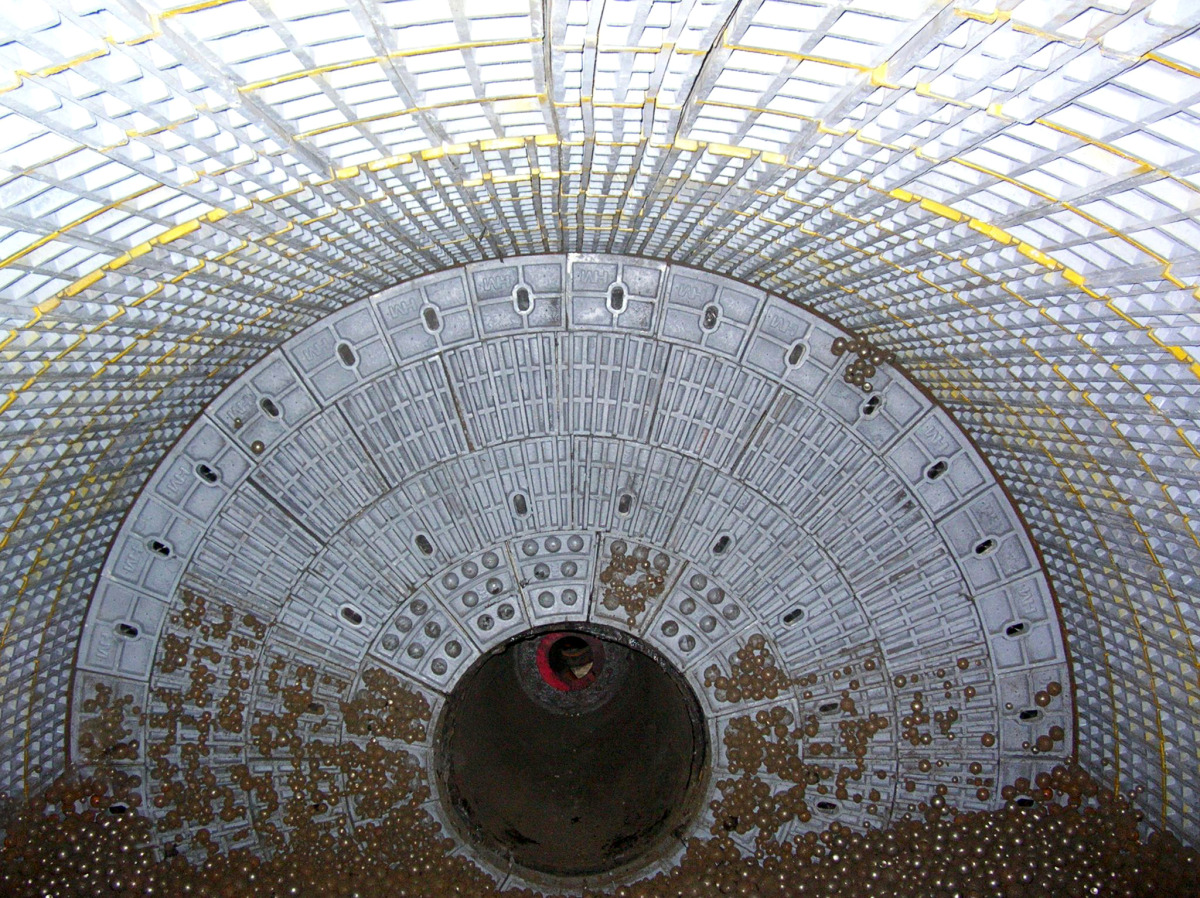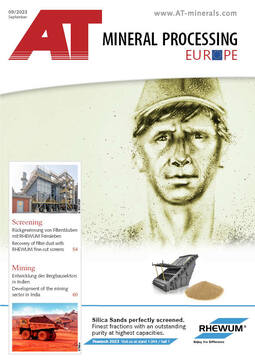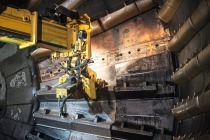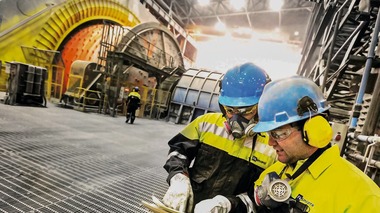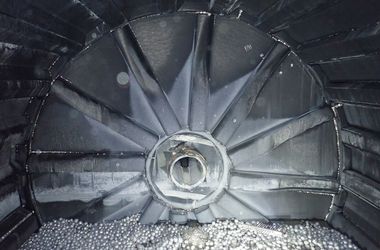Magnetic Mill Liner reduces cost
The MML consists of a permanent magnet embedded in a high chromium alloy molding. The magnet was selected carefully for high quality and superior holding power. The face of the liner is magnetized and accumulates ball chips and ferromagnetic materials to become a 1 to 1,5-inch-thick layer. The MML is protected by the bed of ball chips and magnetic minerals. The ball chips are small and have no grinding properties while staying magnetically charged. The MML utilizes magnetic minerals and ball chips, which consistently replenish themselves for continuous protection of the liner and shell.
Installation
The installation process for the MML was simple, easy and safe – especially when compared to conventional metallic or rubber liners. The heaviest MML piece is about 20 kg (45 pounds). The magnetic mill liner can be installed with charge in place, saving time and labor for installation. There is no need for a special crane, and the worksite is much safer for workers and their hands, especially.
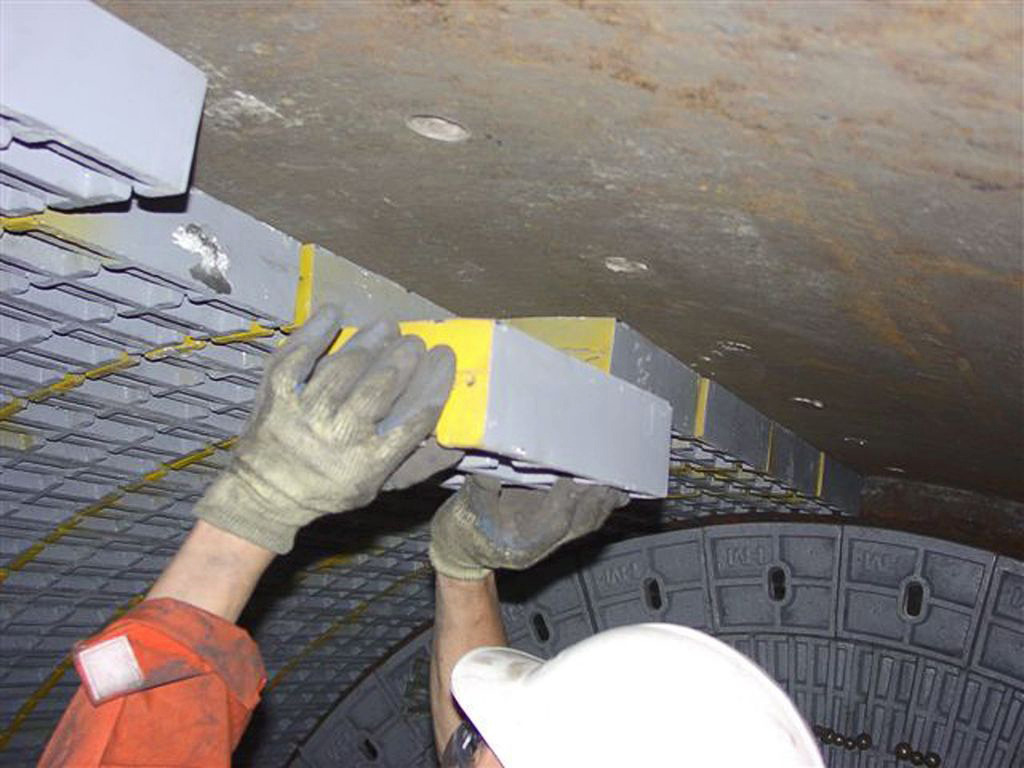 2 Installation of the magnetic mill lining system
2 Installation of the magnetic mill lining system
© Eriez
In a retrofit application, the existing bolt holes are plugged and sealed with rubber plugs. No modification is needed. The MML takes about 8 to 10 hours to install compared to a conventional mill liner that takes about three eight-hour shifts, 24 hours, to install. Therefore, the cost savings for Nexa are significant.
The most important aspect of installing the MML is safety. In fact, Nexa won International Safety honors in Peru. Their safety award covered several aspects about the MML installation identified by Nexa:
Improved safety of the maintenance crew because they did not have to move/manipulate heavy sections of conventional liners to install the liner. Each conventional liner section could weigh as much as 300 kg.
The installation of heavy conventional liners put employees at risk of being hurt if any of the very specialized installation equipment failed.
The installation crew did not have to install fasteners and torque every nut. In a typical mill, all the nuts that hold the conventional liners require re-torquing one week after startup.
According to Nexa, the MMLs are “greener” because they have a lower carbon footprint when you consider the fuel needed for the transportation and material handling equipment required to install heavy conventional liners inside the mine/mill.
Finally, Nexa realized the installation generated less noise than that produced by conventional metallic liners. This was a critical consideration in this work environment.
Advantages of the magnetic mill liner
The life of the magnetic mill liner depends on the discharge type, mill diameter, ball size, magnetic permeability of ball and magnetic mineral content in feed. It has been observed that the MML lasts two to three times longer than rubber or metallic liners. The performance of the metal magnetic liner is consistent during the period of its life. The MML features up to six times the life of a manganese steel liner, while up to three times the life of other bolt-type liners. The longest period a MML has been in use has been 14 years. Currently, the largest ball mill size that the MML can accommodate is 5.5 m in diameter. The ball size is limited to approx. 6,35 bis 7,60 cm (2,5 to 3 inches) in diameter depending upon the hardness. Eriez and others are searching for harder alloys to handle larger-diameter mills and harder minerals.
Small ball chips in the typical ball mill have no grinding function, so the energy for grinding ball chips is wasted. As much as 11 % more energy is consumed while grinding ball chips. The energy used to wear out the conventional steel liner is eliminated with the use of the MML. Ball chips will not grind ore. However, they occupy the volume of the charge, resulting in less grinding efficiency. The MML is the best way to sort out the ball chips and convert them into a protective layer. The high coefficient friction of the ball chips’ bed helps to transfer the energy to the charge. The dominant grinding effects occur inside the charge, not between the charge and the liner. Transferring energy to charge is very important for higher grinding efficiency.
For conventional liners, any void between a liner and shell or head results in back washing wear, which damages the shell and head. Because the MML attracts magnetic particles, it fills up any voids between liner and shell or head to prevent back-washing wear.
No maintenance is required with the MML. The ball chips replenish themselves to provide continuous protection. There is no need to tighten bolts which may loosen over time with other options. No bolts are needed with the new MML design.
Conclusion
Mill lining costs account for up to 5 % of the overall cost of mineral processing, which can be significant. The MML is a maintenance-free mill lining that reduces downtime dramatically and represents major cost savings for most applications. This Nexa case study underscores cost savings, safety and an improved working environment. The MML has been installed in iron ore, copper, nickel and gold mines as well as other nonferrous mines. Magnetic Mill Liners sort out fine ball chips to increase effective charge volume and enhance grinding efficiency found in old ball mills. The energy used for the grinding liner is eliminated, saving the energy cost of grinding within old ball mills.

